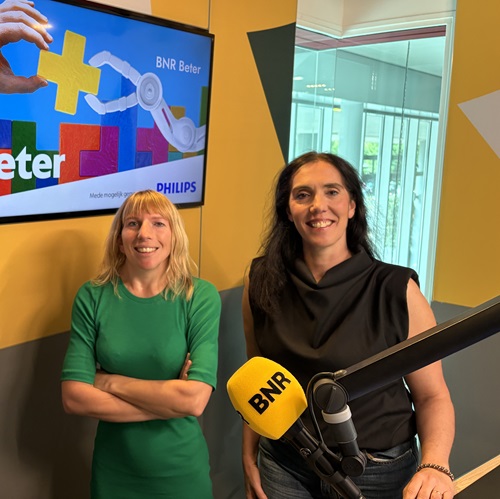About Dr. I. (Ines) Chaves, PhD
Introduction
Introduction

Inês Chaves is an Assistant Professor in the Department of Molecular Genetics at Erasmus University Medical Center, where she investigates the circadian clock at both molecular and organismal levels. Her research has focused on: i) unraveling the role of cryptochromes in the circadian molecular oscillator; ii) exploring the connection between the circadian clock and the cell cycle, and its implications for drug toxicity and cancer chemotherapy; iii) assessing the adverse effects of developmental circadian disruption; and iv) examining the metabolic consequences of perturbing the FOXO3–CLOCK axis.
Currently, her lab investigates health risks linked to circadian disruption. As part of the BioClock Consortium, the team studies how aberrant light exposure during development impacts health, and how strengthening circadian rhythms can improve outcomes. Their goal is to uncover underlying epigenetic mechanisms and identify biomarkers associated with circadian resilience.
Field(s) of expertise
Fields of expertise
Dr. Inês Chaves is a chronobiologist focused on strategies to mitigate the negative effects of circadian misalignment. Her research examines lifelong health impacts of perinatal circadian disturbance and explores optimal light regimes for neonatal care. At Erasmus MC’s Clock Lab, her team studies the circadian clock at both molecular and organismal levels, with a particular emphasis on understanding the health consequences of circadian disruption and developing interventions to minimize these effects. Notably, her work has demonstrated lasting adverse outcomes of developmental circadian disturbance in animal models.

Key scientific contributions include:
- Demonstrating that photolyases can rescue circadian oscillations in cryptochrome-deficient cells and tissues;
- Identifying FOXO3 as a critical link between the circadian oscillator and metabolism, and as a direct transcriptional regulator of Clock;
- Revealing severe health effects and epigenetic reprogramming associated with developmental circadian disturbance.
Impact of perinatal circadian disturbance on later life health and sleep
Hospital environments often disrupt natural circadian rhythms through noise, irregular interruptions, and atypical light cycles, factors that impair sleep and slow recovery. Research shows that light conditions in Neonatal Intensive Care Units (NICUs) influence short-term outcomes in preterm infants, with cycling light promoting faster weight gain, quicker recovery, and shorter hospital stays compared to constant light or near-darkness.
Preterm infants miss critical periods of in-utero circadian entrainment and maternal regulation. Feeding practices further complicate this: expressed breast milk delivered via tubes lacks the natural timing cues aligned with maternal rhythms. Since breast milk composition varies across day and night to meet infants’ evolving needs, understanding this relationship could help restore circadian balance.
Our ultimate goal is to optimize feeding timing and composition in neonatal care and assess its impact on growth, sleep, neurodevelopment, and circadian system maturation, both short- and long-term.
Education and career
Education and career

Inês Chaves studied Biochemistry at the University of Porto and did her PhD at the Netherlands Cancer Institute, where she studied transcriptional regulation of antigenic variation in T. brucei.
After that she moved to the Erasmus MC in Rotterdam for her post-doc.
Publications
Publications
- Coppens G, Cramer ABG, Vanhorebeek I, Güiza F, Wouters PJ, Chaves I, de Hoog M, Dulfer K, Joosten KFM, Van den Berghe G, Verbruggen SCAT. Aberrant DNA methylation within circadian entrainment and clock genes two years after pediatric critical illness is associated with impaired physical and neurocognitive development. Clin Epigenetics. (2025) Nov 23.
- Marques IF, Domènech-Panicello C, Geurtsen ML, Hoang TT, Richmond R, Polinski K, Sirignano L, Page CM, Binter AC, Everson T, Burt A, Deuschle M, Gilles M, Streit F, Mumford SL, Magnus P, Reiss IKM, Vermeulen MJ, Witt SH, Chaves I, Yeung E, London SJ, Guxens M, Felix JF. Associations of maternal night shift work during pregnancy with DNA methylation in offspring: a meta-analysis in the PACE consortium. Clin Epigenetics. (2024) 17(1):12.
- Brouwers TMJ, Çobanoğlu ÜG, Geers D, Rietdijk WJR, Gommers L, Bogers S, Lammers GJ, van der Horst GTJ, Chaves I, GeurtsvanKessel CH, Koch BCP, de Vries RD, van Baarle D, van der Kuy HM, Lammers-van der Holst HM.The effect of sleep and shift work on the primary immune response to messenger RNA-based COVID-19 vaccination. J Sleep Res. (2025) 34(4):e14431.
- van der Rhee M, Oosterman JE, Wopereis S, van der Horst GTJ, Chaves I, Dollé MET, Burdorf A, van Kerkhof LWM, der Holst HML. Personalized sleep and nutritional strategies to combat adverse effects of night shift work: a controlled intervention protocol. BMC Public Health. (2024) 24:2555.
- Richie C, Garcia-Gomez P, Thio HB, Rwei A, Joo C, ..., Anna Bornioli, Chaves I, Dik WA (2024) Research on the health impact of climate must consider distributive justice and environmental sustainability. PLOS Climate (2024) 3: e0000431.
- van Gilst D, Puchkina AV, Roelants JA, Kervezee L, Dudink J, Reiss IKM, Van Der Horst GTJ, Vermeulen MJ, Chaves I. Effects of the neonatal intensive care environment on circadian health and development of preterm infants. Front Physiol. (2023) 14:1243162.
- Oster H, Chaves I. Effects of Healthy Lifestyles on Chronic Diseases: Diet, Sleep and Exercise. Nutrients. (2023) 15:4627.
- Draijer S, Timmerman R, Pannekeet J, van Harten A, Farshadi EA, Kemmer J, van Gilst D, Chaves I, Hoekman MFM. FoxO3 Modulates Circadian Rhythms in Neural Stem Cells. Int J Mol Sci. (2023) 24:13662.
- Streng AA, Van Dycke KCG, van Oostrom CTM, Salvatori DCF, Hulsegge G, Chaves I, Roenneberg T, Zander SAL, van Steeg H, van der Horst GTJ, van Kerkhof LWM. Impact of Simulated Rotating Shift Work on Mammary Tumor Development in the p53R270H©/+WAPCre Mouse Model for Breast Cancer. J Biol Rhythms. (2023) 38:476-491.
- Streng AA, Loef B, Dollé MET, van der Horst GTJ, Chaves I, Proper KI, van Kerkhof LWM. Night shift work characteristics are associated with several elevated metabolic risk factors and immune cell counts in a cross-sectional study. Sci Rep. (2022) 12:2022.
- Caliandro R, Streng AA, van Kerkhof LWM, van der Horst GTJ, Chaves I. Social Jetlag and Related Risks for Human Health: A Timely Review. Nutrients. (2021) 13:4543.
- Lammers-van der Holst HM, Lammers GJ, van der Horst GTJ, Chaves I, de Vries RD, GeurtsvanKessel CH, Koch B, van der Kuy HM. Understanding the association between sleep, shift work and COVID-19 vaccine immune response efficacy: Protocol of the S-CORE study. J Sleep Res. (2021) 6:e13496.
- Italianer MF, Naninck EFG, Roelants JA, van der Horst GTJ, Reiss IKM, Goudoever JBV, Joosten KFM, Chaves I, Vermeulen MJ. Circadian Variation in Human Milk Composition, a Systematic Review. Nutrients. (2020) 12:2328.
- Farshadi E, van der Horst GTJ, Chaves I. Molecular Links between the Circadian Clock and the Cell Cycle. J Mol Biol. (2020) 432:3515-3524.
- Dimova EY, Jakupovic M, Kubaichuk K, Mennerich D, Chi TF, Tamanini F, Oklejewicz M, Hänig J, Byts N, Mäkelä KA, Herzig KH, Koivunen P, Chaves I, van der Horst G, Kietzmann T. The Circadian Clock Protein CRY1 Is a Negative Regulator of HIF-1α. iScience. (2019) 13:284-304.
- Chaves I, van der Eerden B, Boers R, Boers J, Streng AA, Ridwan Y, Schreuders-Koedam M, Vermeulen M, van der Pluijm I, Essers J, Gribnau J, Reiss IKM, van der Horst GTJ. Gestational jet lag predisposes to later-life skeletal and cardiac disease. Chronobiol Int. (2019) 36:657-671.
- Farshadi E, Yan J, Leclere P, Goldbeter A, Chaves I, van der Horst GTJ. The positive circadian regulators CLOCK and BMAL1 control G2/M cell cycle transition through Cyclin B1. Cell Cycle. (2019) 18:16-33.
- Draijer S, Chaves I, Hoekman MFM. The circadian clock in adult neural stem cell maintenance. Prog Neurobiol. (2019) 173:41-53.
- van den Berg CB*, Chaves I*, Herzog EM, Willemsen SP, van der Horst GTJ, Steegers-Theunissen RPM. Early- and late-onset preeclampsia and the DNA methylation of circadian clock and clock-controlled genes in placental and newborn tissues. Chronobiol Int. (2017) 34:921-932.
*equal contribution - Russcher M*, Chaves I*, Lech K, Koch BC, Nagtegaal JE, Dorsman KF, Jong A', Kayser M, van Faassen HM, Kema IP, van der Horst GT, Gaillard CA. An observational study on disturbed peripheral circadian rhythms in hemodialysis patients. Chronobiol Int. (2015) 32:848-57.
- Binkhorst L, Kloth JSL, de Wit AS, de Bruijn P, Lam MH, Chaves I, Burger H, van Alphen RJ, Hamberg P, van Schaik RHN, Jager A, Koch BCP, Wiemer EAC, van Gelder T, van der Horst GTJ, Mathijssen RHJ. Circadian variation in tamoxifen pharmacokinetics in mice and breast cancer patients. Breast Cancer Res Treat. (2015) 152:119-128.
- Kloth JS, Binkhorst L, de Wit AS, de Bruijn P, Hamberg P, Lam MH, Burger H, Chaves I, Wiemer EA, van der Horst GT, Mathijssen RH. Relationship Between Sunitinib Pharmacokinetics and Administration Time: Preclinical and Clinical Evidence. Clin Pharmacokinet. (2015) 54:851-8.
- Chaves I, van der Horst GT, Schellevis R, Nijman RM, Koerkamp MG, Holstege FC, Smidt MP, Hoekman MF. Insulin-FOXO3 signaling modulates circadian rhythms via regulation of clock transcription. Curr Biol. (2014) 24:1248-55.
- Biernat MA, Eker AP, van Oers MM, Vlak JM, van der Horst GT, Chaves I. A baculovirus photolyase with DNA repair activity and circadian clock regulatory function. J Biol Rhythms. (2012) 27:3-11.
- Chaves I, Nijman RM, Biernat MA, Bajek MI, Brand K, da Silva AC, Saito S, Yagita K, Eker AP, van der Horst GT. The Potorous CPD photolyase rescues a cryptochrome-deficient mammalian circadian clock. PLoS One. (2011) 6:e23447.
- Chaves I, Pokorny R, Byrdin M, Hoang N, Ritz T, Brettel K, Essen LO, van der Horst GT, Batschauer A, Ahmad M. The cryptochromes: blue light photoreceptors in plants and animals. Annu Rev Plant Biol. (2011) 62:335-64.
- Eker AP, Quayle C, Chaves I, van der Horst GT. DNA repair in mammalian cells: Direct DNA damage reversal: elegant solutions for nasty problems. Cell Mol Life Sci. (2009) 66:968-80.
- Tamanini F, Chaves I, Bajek MI, van der Horst GT. Structure function analysis of mammalian cryptochromes. Cold Spring Harb Symp Quant Biol. (2007) 72:133-9.
- Chaves I, Yagita K, Barnhoorn S, Okamura H, van der Horst GT, Tamanini F. Functional evolution of the photolyase/cryptochrome protein family: importance of the C terminus of mammalian CRY1 for circadian core oscillator performance. Mol Cell Biol. (2006) 26:1743-53.
- Cross M, Kieft R, Sabatini R, Dirks-Mulder A, Chaves I, Borst P. J-binding protein increases the level and retention of the unusual base J in trypanosome DNA. Mol Microbiol. (2002) 46:37-47.
- Albus H, Bonnefont X, Chaves I, Yasui A, Doczy J, van der Horst GT, Meijer JH. Cryptochrome-deficient mice lack circadian electrical activity in the suprachiasmatic nuclei. Curr Biol. (2002) 12:1130-3.
- Ulbert S, Chaves I, Borst P. Expression site activation in Trypanosoma brucei with three marked variant surface glycoprotein gene expression sites. Mol Biochem Parasitol. (2002) 120:225-35.
- Dooijes D, Chaves I, Kieft R, Dirks-Mulder A, Martin W, Borst P. Base J originally found in kinetoplastida is also a minor constituent of nuclear DNA of Euglena gracilis. Nucleic Acids Res. (2000) 28:3017-21.
- Shearman LP, Sriram S, Weaver DR, Maywood ES, Chaves I, Zheng B, Kume K, Lee CC, van der Horst GT, Hastings MH, Reppert SM. Interacting molecular loops in the mammalian circadian clock. Science. (2000) 288:1013-9.
Teaching activities
Teaching activities and Outreach

Dr. Inês Chaves contributes to education across multiple programs at Erasmus MC. She is part of the teaching teams for BSc Medicine, BSc Nanobiology, and MSc Nanobiology, and serves on the Board of Examiners for Nanobiology. In addition, she delivers guest lectures for the MSc Neuroscience (Erasmus MC) and MSc Biomedical Sciences (LUMC).
Opportunities Student projects and Internship
Students interested in circadian biology and its health implications are welcome to apply for internships.Outreach
Inês Chaves actively promotes awareness of circadian health through outreach initiatives.Other positions
Dr. I. Chaves is member of the executive borad of the BioClock Consortium.


